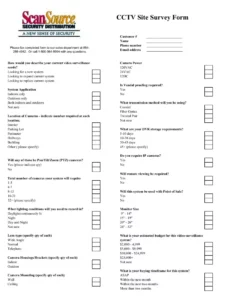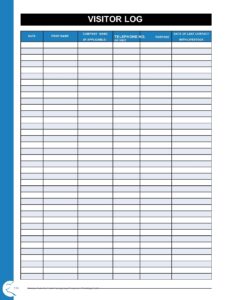In today’s data-driven world, the physical security of your server room isn’t just a recommendation; it’s a critical necessity. This goes beyond locked doors and surveillance cameras; it extends to knowing exactly who enters and exits these sensitive areas, and when. Without a clear record, you’re leaving a significant gap in your security posture, potentially compromising valuable data and exposing your organization to risks.
That’s where a well-designed server room access log template comes into play. It’s more than just a piece of paper or a digital form; it’s your frontline defense for maintaining accountability, ensuring compliance, and providing an invaluable audit trail should any issues arise. Let’s dive into why having such a template is not just good practice, but an absolute must-have for any organization serious about its data integrity and security.
The Indispensable Role of a Robust Server Room Access Log
Imagine a scenario where a critical server goes offline, or data appears to have been tampered with. Your first question will likely be, “Who was in the server room?” Without a meticulously kept log, answering that question becomes a challenging, time-consuming, and potentially fruitless endeavor. A robust server room access log template acts as your unbiased witness, providing concrete evidence of every entry and exit. This level of detail is crucial not only for security but also for operational integrity.
Beyond immediate security concerns, a detailed access log helps with compliance. Many industry regulations and certifications, such as HIPAA for healthcare data, GDPR for personal data in Europe, and SOX for financial reporting, require organizations to demonstrate stringent control over access to sensitive information and the infrastructure that houses it. A comprehensive log proves due diligence, showing auditors that you have established and are enforcing clear protocols for physical security. It transforms what could be a headache into a straightforward demonstration of adherence.
Furthermore, these logs are incredibly valuable for internal auditing and troubleshooting. If you’re experiencing recurring issues with a particular piece of hardware or a network segment, cross-referencing system logs with physical access logs can help identify patterns or even pinpoint a specific visit that might have coincided with the start of the problem. This can significantly reduce diagnostic time and help prevent future incidents by revealing potential training needs or process improvements. It’s an investigative tool that connects physical actions to digital outcomes.
Essential Details to Include in Your Access Log
When designing or choosing your server room access log template, ensure it captures all the necessary information to make it truly effective. Skimping on details here can undermine the entire purpose of the log. Think of it as telling a complete story about each person’s visit.
Here are the critical fields that every template should feature:
* Date and Time of Entry
* Date and Time of Exit
* Full Name of the Individual
* Company or Department Affiliation
* Purpose of Visit (e.g., routine maintenance, hardware installation, troubleshooting, audit)
* Specific Equipment Accessed or Worked On (if applicable)
* Authorization Approver (who granted permission for entry)
* Signature of the Visitor
* Signature of the Escort (if an escort policy is in place)
* Any Unusual Observations or Comments
Having these data points readily available streamlines investigations and helps maintain a high level of accountability. It also provides a deterrent, as individuals know their access is being carefully documented. The more comprehensive your log, the stronger your security posture becomes, making it harder for unauthorized actions to go unnoticed or unaddressed.
Crafting and Implementing Your Ideal Server Room Access Log Template
Creating an effective server room access log template isn’t about finding a one-size-fits-all solution; it’s about tailoring one that meets your specific organizational needs and security policies. While many templates are available online, the most effective ones are usually customized. Consider whether a physical, paper-based logbook works best for your environment, or if a digital solution, perhaps integrated with an access control system, would be more efficient and secure. Each option has its merits, depending on your resources and existing infrastructure.
Regardless of the format you choose, ease of use is paramount. If the log is cumbersome or difficult to fill out, personnel might bypass it, defeating its purpose. Design the template with clear fields, concise instructions, and a logical flow. For digital versions, ensure it’s accessible and intuitive, perhaps with dropdown menus or auto-fill options for common entries. The goal is to make logging access a seamless part of the routine, not an arduous task that people try to avoid.
Integration with your existing security protocols is also key. Your server room access log template should complement your entry procedures, not stand alone. For instance, if you have a badge access system, the log can serve as a secondary verification, requiring a signature in addition to a badge scan. This layered approach enhances security and provides redundancy in your audit trail. Regular training for all personnel who require server room access on the importance and correct usage of the log is essential to ensure consistent compliance.
Finally, remember that a template is only as good as its implementation and review process. Regularly audit your completed access logs for completeness and accuracy. Look for inconsistencies, missing entries, or unusual patterns that might indicate a lapse in security or a need for process improvement. Periodically review the template itself to ensure it still meets your evolving security needs and compliance requirements, making adjustments as necessary to keep it a relevant and effective tool.
Implementing a robust server room access logging system offers tangible benefits, providing peace of mind knowing that your critical infrastructure is protected and every interaction is meticulously documented. It’s a proactive measure that safeguards against potential threats and reinforces a culture of accountability within your organization.
By embracing a detailed logging strategy, you are not just fulfilling a security requirement; you are investing in the resilience and integrity of your entire IT ecosystem. This diligent approach ensures that your most valuable digital assets remain secure, accessible, and free from unauthorized interference, laying a strong foundation for your organization’s continued success and stability.

